Water and Sewer Projects
Learn about Markham's current water and sewer projects.
Flood Control Projects
Learn more about Markham's Water and Sewer Projects.
- West Thornhill – Phase 3C/4A/4B: Storm Sewer Replacement
West Thornhill – Phase 3C/4A/4B: Storm Sewer Replacement
Project Description
The City of Markham has upgraded storm sewers, watermains and sanitary sewers within the West Thornhill area as part of the City’s flood control program, as shown in the map below. Recent projects included upgrades in areas of:
- Phase 3A: Clark Ave./Henderson Area,
- Phase 3B: Johnson Street from Clark Avenue to John Street and watermains (St, Andres Court, Ida Street, Dove Lane, Wiarton Court),
- Phase 3C: Glen Cameron Road/ Clark Ave/ Lilian Ave/ Mira Road/ Pheasant Valley Court.,
- Phase 4A: Royal Orchard Area / Kirk Drive, and
- Phase 4B: Romfield Circuit. Construction in these areas has been completed as of August 2021, October 2021, September 2023, November 2022, and June 2024, respectively.
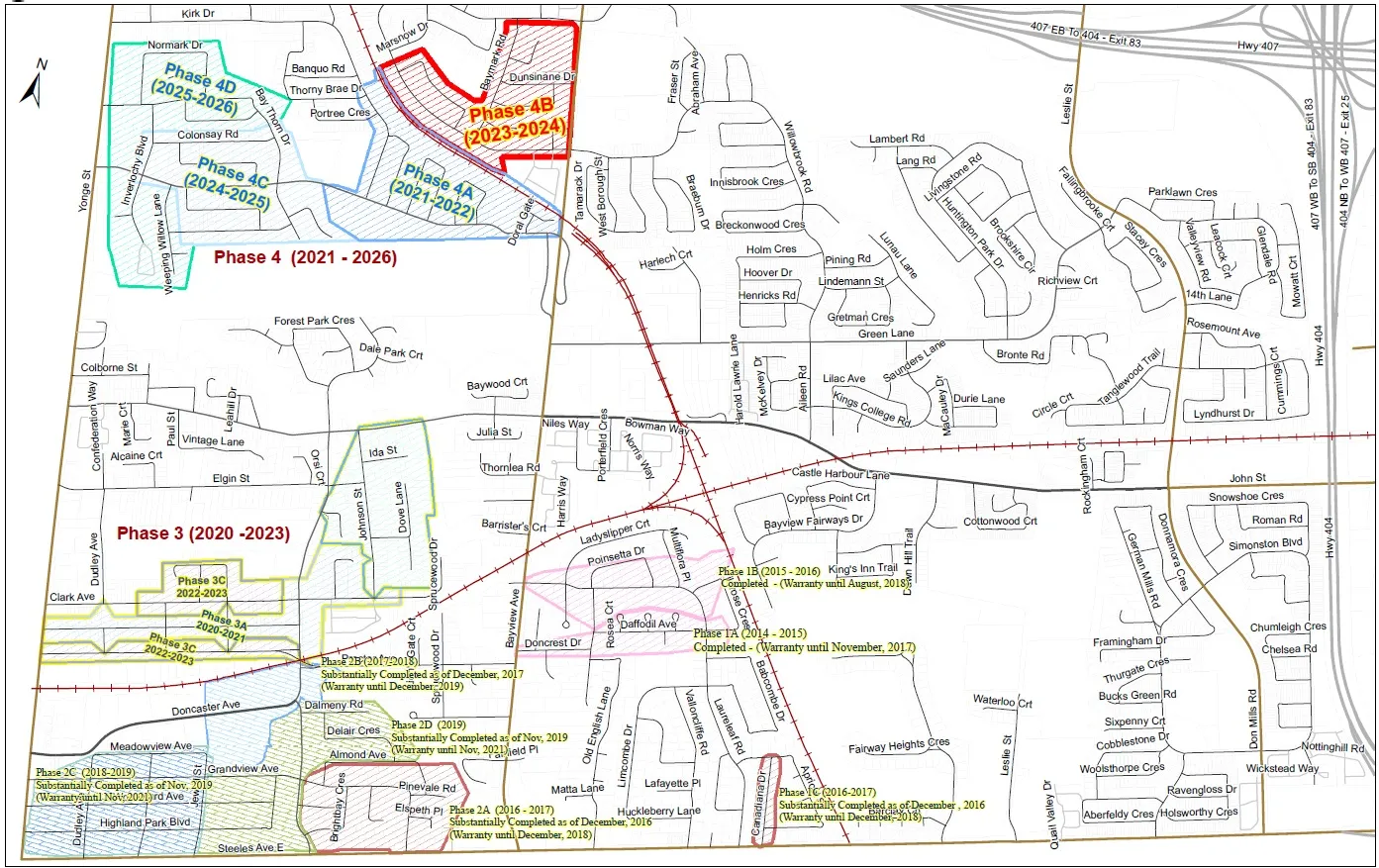
Project Activities
Phase 3 construction activities were identified at Community Information Meetings in advance of the various construction project. Details are provided in the slide presentation delivered by City staff and its design consultant RVA –See here for Phase 3A Presentation, Phase 3B Presentation, Phase 3C Presentation
Phase 4A and 4B construction activities were also identified at Community Information Meetings. Those presentations provide details through the Phase 4A Presentation and Phase 4B Presentation.
Disaster Mitigation Adaptation Fund (DMAF)
These projects including final design and construction are funded in part by the Government of Canada through the Disaster Mitigation and Adaptation Fund.

Contact Information:
Jawaid Khan, M.Eng, P.Eng.
Senior Project Manager, Water and Wastewater, Environmental Services Department
Tel: (905) 477-7000 ext. 2637
Email: jkhan@markham.ca- Markham Village/Unionville Flood Reduction
Markham Village/Unionville Flood Reduction
Background
The City of Markham experienced three significant storm events in June and July 2017 that resulted in 350 reports of flooding throughout the Markham Village and Unionville Areas. In response to these storm events, the City has recognized the need for a comprehensive approach to mitigate the risks of flooding in the areas of Markham Village and Unionville .
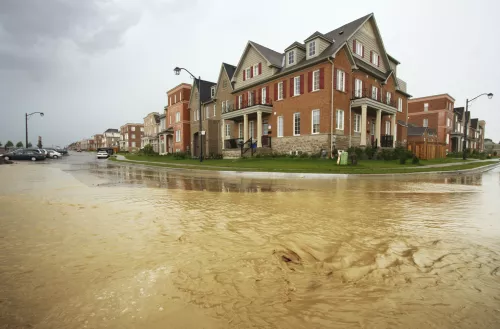
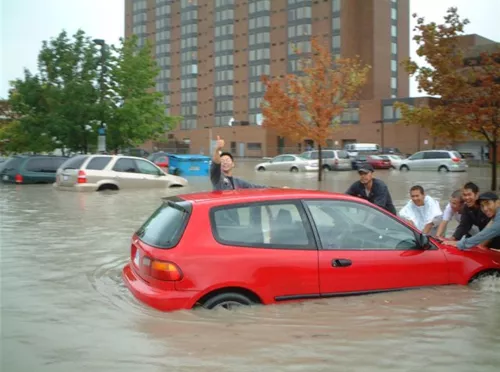
The existing storm sewer system lacks sufficient capacity to manage stormwater runoff during substantial storm events. A majority of the sewer systems in Markham Village and Unionville were planned and built prior to 1978, when the City's design guidelines centered on a 2-year design storm. This design standard no longer aligns with the current guideline, which advocates for a more rigorous and conservative Level of Service (LOS) based on a 100-year design storm. Consequently, upgrades to the sewer system are imperative in certain areas to meet the heightened LOS requirements to accommodate a greater 100-year storm event.
Feasibility Study
In May 2021, a feasibility study for Markham Village and Unionville was successfully completed. The primary objective of this study was to establish a comprehensive planning document, facilitating the subsequent phases of the flood remediation program in Markham Village and Unionville. This includes activities such as financial planning, regulatory approvals, as well as the design and construction phases, scheduled to occur over several years. The figure below shows the project areas divided to four phases.
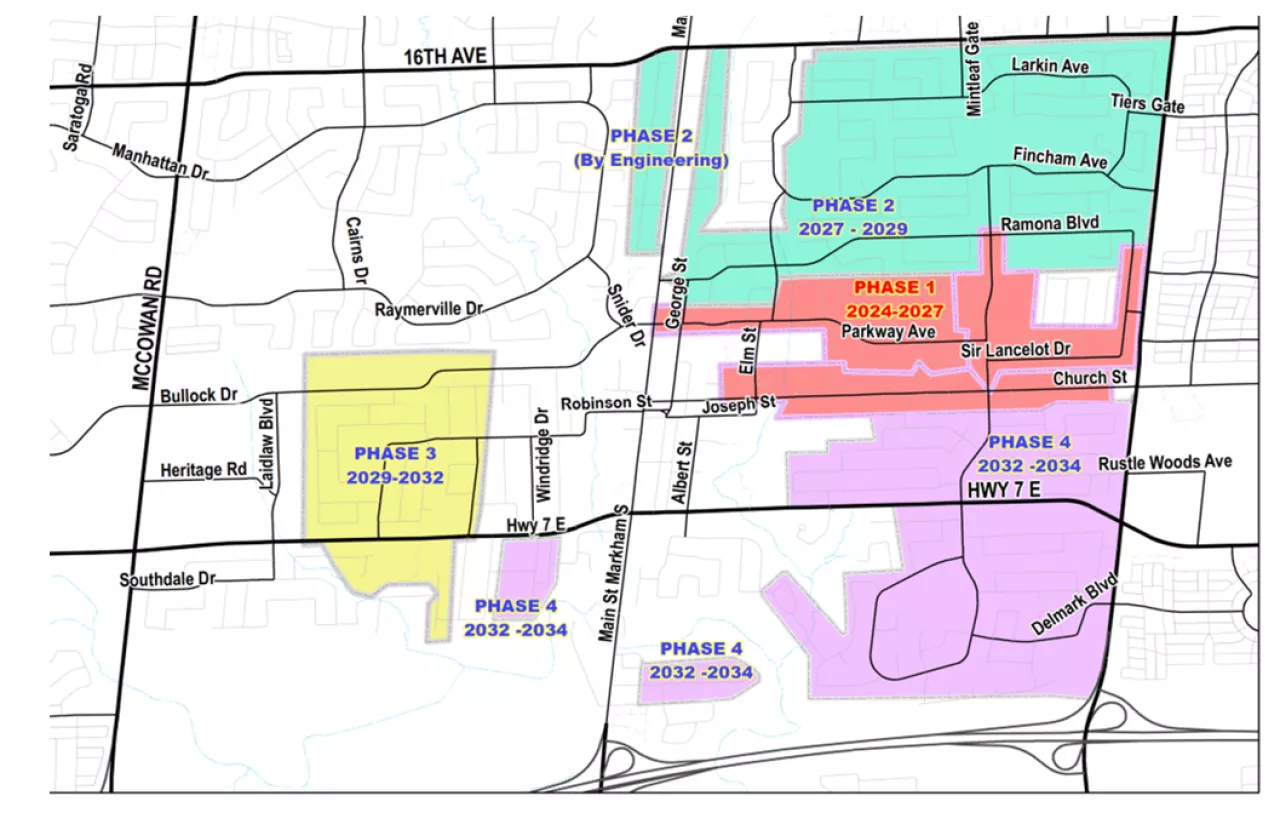
Proposed Solution
The Feasibility Study recommended the following Proposed Solutions:
- Markham Village Phase 1: Multiple Storm sewer, Sanitary Sewer and Watermain upgrades per the following figure within the below roads:
- Phase 1A (completed):
- Stormwater sewer upgrades on Church Street (Maple St. to Wootten Way N. and Wootten Way N. to 200m east of Rose Way), Jack Court, Jill Court, Judy Court, Rose Way (Church St. to Linden Lea St.), and outfall at Mount Joy Creek
- Restoration works on above streets occurring May to October 2025
- Construction is ongoing with anticipated completion in Fall 2025
- Phase 1B (completed):
- Stormwater sewer upgrades on Wootten Way N (Church St to Sir Tristram Pl), Sir Lancelot Drive (Church St to Sir Tristram Pl), Sir Gareth Court, and Sir Kay Dr (Sir Lancelot Dr to Sir Gareth Crt.)
- Construction is scheduled to start Spring 2025 with anticipated completion in Fall 2026
- Phase 1C:
- Stormwater sewer upgrades on Parkway Avenue, Elm Street, Sir Isaac Gate and Sir Galahad Place and sanitary sewer upgrades on Parkway Avenue
- Stormwater sewer upgrades on Parkway Avenue, Elm Street, Sir Isaac Gate and Sir Galahad Place and sanitary sewer upgrades on Parkway Avenue
- Markham Village Phase 2: Multiple Storm sewer and Sanitary Sewer upgrades per the following figure within the below roads:
- Fincham Ave., Daniel Crt., Hallam Rd., Larkin Ave., Ramona Blvd., Brockfield Crt., Sir Constantine Dr., Enos Gate, Bryant Rd., Main Street Markham Rd. N., Peter St., Beech St.,
- Markham Village - Unionville Phase 3: Storm sewer and Sanitary Sewer upgrades per the following figure within the below roads:
- Robinson St., King Richard Crt., Friar Tuck Rd., Alanadale Ave.
4. Markham Village - Unionville Phase 4: Storm sewer and Sanitary Sewer upgrades per the following figure within the following roads:
- Milne Lane, Rouge St., Senator Reesor’s Dr. Henry Corson Pl., Wootten Way S., John Detexer Pl., Captain Armstrong’s Lane, Major Buttons Dr., James Speight Rd., Squire Baker’s Lane.
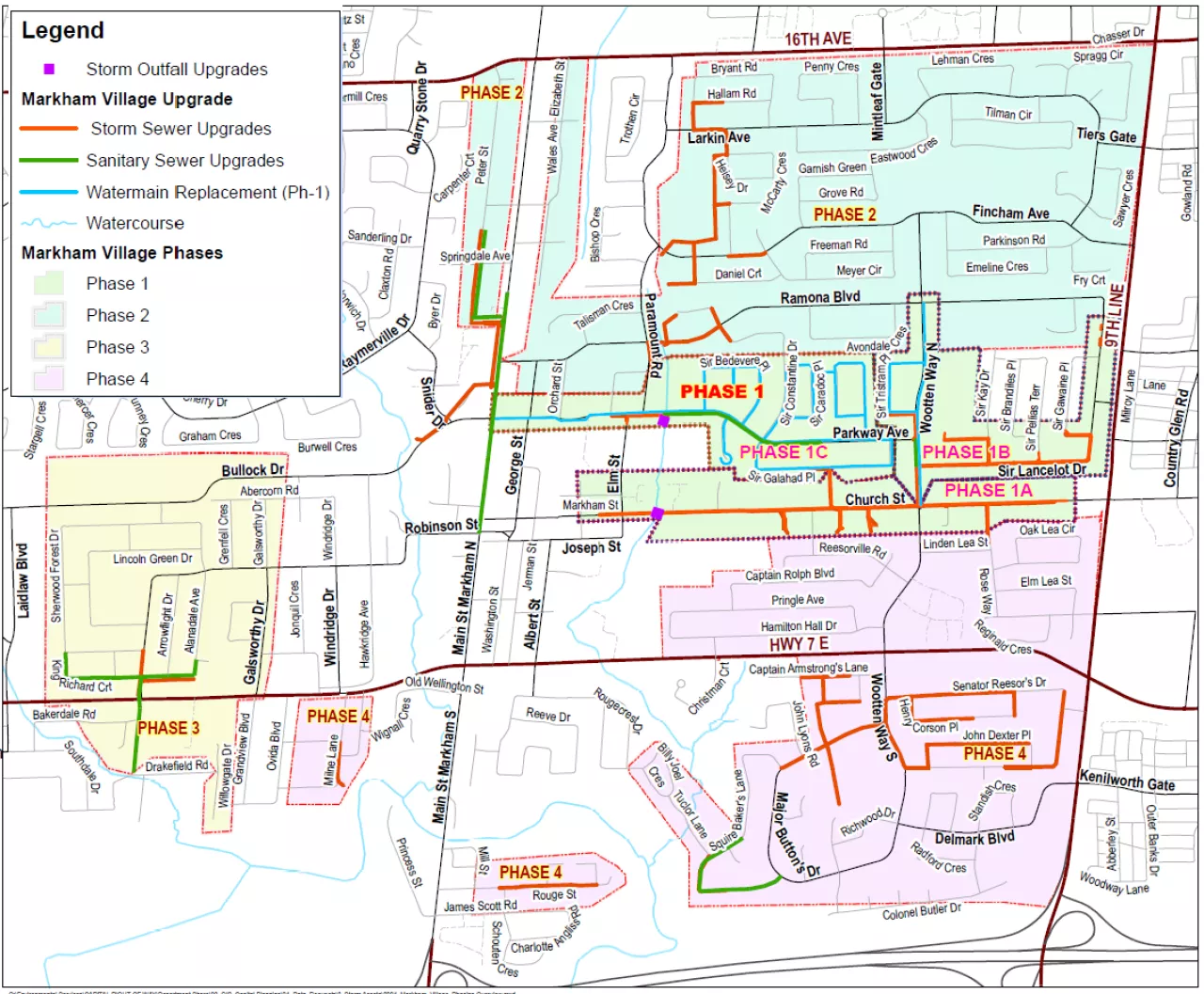
Project Implementation— Phase 1 Design and Construction
The City of Markham retained R. V. Anderson in 2022 to undertake the detailed design for the proposed upgrades within the Markham Village Phase 1 areas (see map above). Proposed solutions identified in the feasibility study were refined through the design and approvals process.
The design of Phase 1 works was completed in early 2024. To inform residents, businesses and impacted stakeholders of upcoming construction work, a Public Information Centre (PIC) was held on February 26, 2024 for Phase 1A work and on March 20, 20235 for phase 1B work at the Markham Village Community Centre.
Planned works were summarized on the following map identifying Phase 1 storm sewer, sanitary sewer and watermain upgrades.
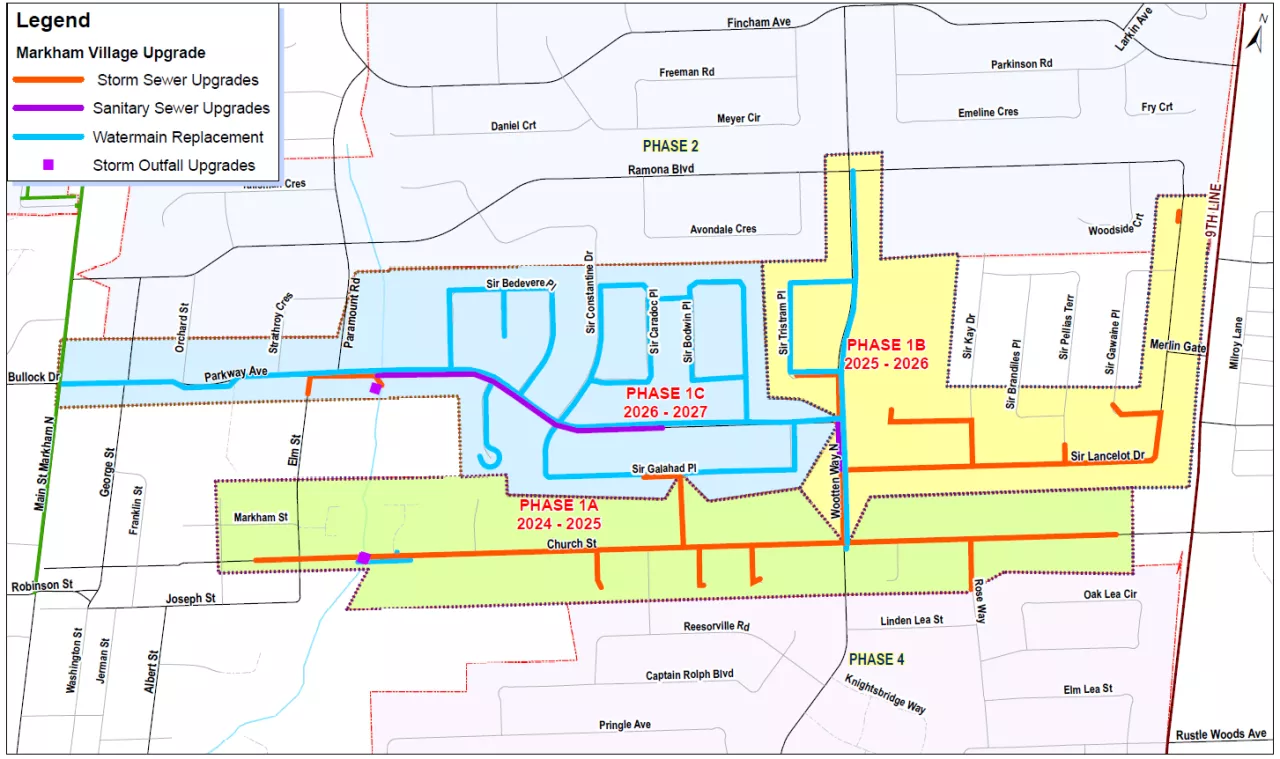
The full presentation including timing of construction, as well as information on traffic management (detours and road closures), can be downloaded under project documents below.
A Request for Tender (RFT) for construction of Phase 1A works was released by the City in December 2023. February 2024 a contractor was selected (see Council report below) to complete works in the Phase 1A area shown below. Drainstar Contracting Ltd. commenced the construction in the Phase 1A area in April 2024.
A Request for Tender (RFT) for construction of Phase 1B works was released by the City in December 2024. In March 2025 a contractor was selected to complete works in the Phase 1B area shown below. Green Infrastructure Partners Inc. will commence the construction in the Phase 1B area in mid-April 2025.
Project Documents and Reports to Council:
- Community Information Meeting (April 26, 2018)— see Presentation
- Markham Village and Unionville Flood Study Council Presentation (April 26, 2020)— see Presentation
- Public Consultation #1 (October 2020)— See Presentation
- Markham Village Implementation Plan (April 2021)— see Report
- Public Consultation #2 (June 2021)— See Presentation
- Markham Village and Unionville Flood Mitigation Study General Committee Meeting (October 2021)— See Presentation
- Recommendation for Award of 289-T-23 Markham Village Phase 1A - Storm Sewers and Watermain Upgrades — see Report
- Markham Village Flood Control Implementation Project Phase 1A Community Information Meeting — See Presentation
- Markham Village Flood Control Implementation Project Phase 1B Community Information Meeting — See Presentation
Contact information:
Robert Muir, Manager, Stormwater
Email: rmuir@markham.ca
Phone: 905.477.7000 x 2357- Don Mills Channel Flood Storage Facility and Culvert Upgrade
Exciting Improvements Coming to 55, 85,115,135 Torbay Road – Construction Begins July/August 2025
We’re investing in a safer, greener, and more beautiful community! Starting in July/August 2025, construction will begin near 55,85,115,135 Torbay Road to deliver a series of important upgrades that will benefit both residents and the environment. The project is anticipated to be completed in the first quarter of 2026.
Flood Protection
A new flood control facility will be built to significantly reduce stormwater flooding in the Don Mills Channel Urban Area, helping to protect the public, roads, businesses, and infrastructure.Cleaner Waterways
Three Oil Grit Separator units will be installed to improve the quality of water flowing downstream—supporting healthier ecosystems and cleaner local waterways.Naturalized Channel Enhancements
A section of the channel will be transformed with naturalized landscaping and rock lining, enhancing the area’s beauty while reducing erosion and improving long-term sustainability.Ecological Revitalization
We’re planting over 200 trees and 500 shrubs to boost local biodiversity, create more green space, and contribute to a healthier urban environment.These improvements are part of our commitment to building a more diverse, thriving, vibrant safe and sustainable community. We appreciate your patience during construction and look forward to unveiling a revitalized space.
The location of the flood control facility is shown in the image below highlighted in light green.
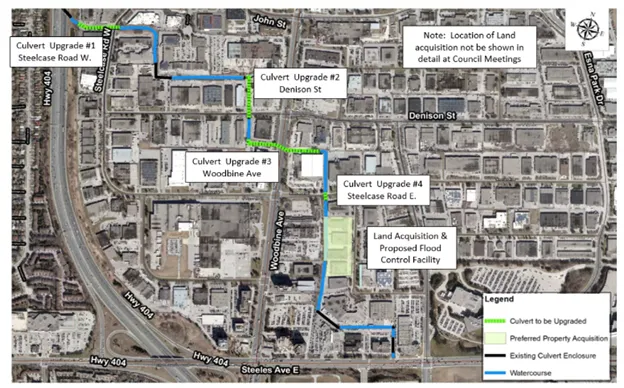
For further information about the background of the Don Mills Channel and the future plans to reduce flooding near the Don Mills Channel Urban area, including several culvert upgrades currently undergoing design, see this page.
This project including property acquisition, final design, and construction is funded in part by the Government of Canada through the Disaster Mitigation and Adaptation Fund.

Contact Information:
Timothy Ng, P.Eng.
Project Engineer, Stormwater, Environmental Services Department
Tel: (905) 477-7000 ext. 2374
Email: tng@markham.ca- Glynnwood Tributary Area Sewer Surcharge Flood Remediation
The City completed the Glynnwood Tributary Area Surcharge & Glynnwood /Shouldice Pond Restoration Implementation of Various Flood Remediation Class Environmental Assessment in 2023- See Report.
Operation, Maintenance and Rehabilitation Projects
- Stormwater Facilities Cleanout Projects
Sediment Removal at Ponds 55 and 60
Project Description
The City of Markham will be removing sediment and performing maintenance at two stormwater management ponds. Pond 55 is located southeast of Song Bird Drive. Pond #60 is within the boundaries of Kennedy Road, Highway No. 7, McCowan Road and Highway 407.
The City of Markham undertakes periodic inspections of its stormwater management facilities, including Ponds 55 and60, as part of its stormwater management maintenance program. This includes visual inspections and reports, as well as periodic bathymetric (i.e., sediment level) surveys. Through this process, the need to remove accumulated sediment in Ponds 55 and 60 have been identified to ensure efficient operation.
Project Activities
- Flushing and cleanout of pond infrastructure (e.g., sewer pipes) ;
- Sediment removal from ponds and disposal off-site;
- Planting vegetation and seeding; and
- Clean-up and restoration of the site after completion of the work.
While there will be some inconvenience to the residents who live around the construction site and general public who work near the area, the Contractor and the City staff will work together to complete the project as quickly as possible. All areas disturbed during construction will be restored to their original conditions.
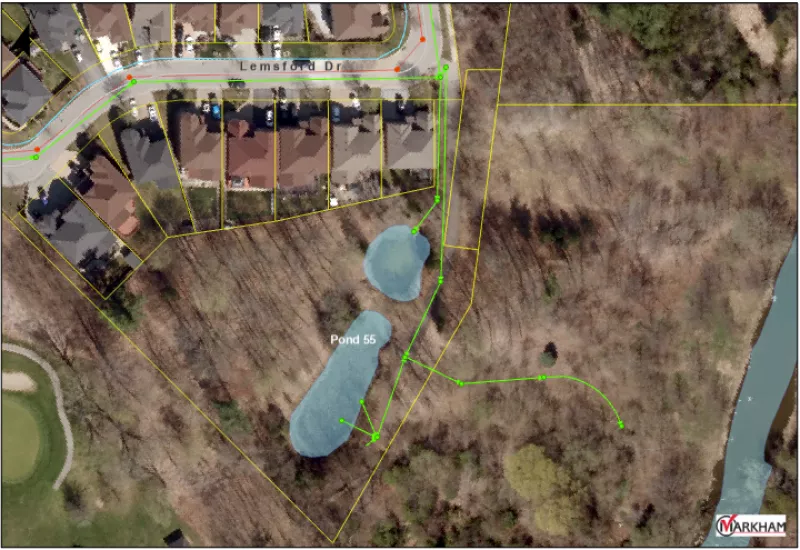
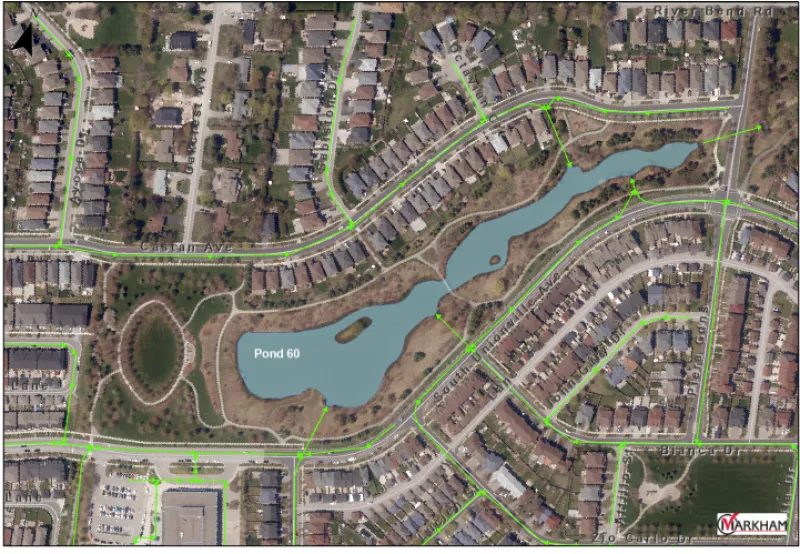
Schedule
The construction is scheduled to begin at the beginning of June 2025 and is expected to be completed by the end of October 2025, weather permitting. During the construction, roadways will be open at the above noted locations.
Contact information:
Timothy Ng, P.Eng.
Project Engineer, Stormwater,
Environmental Services Department
Tel: (905) 477-7000 ext. 2374
Email: tng@markham.ca- Erosion Restoration Projects
Erosion Restoration at Mill St.
Project Description
The City of Markham will be rehabilitating an erosion site on Rouge River north of Mill Street. The site experienced a slope failure and loss of a street light in 2023 such that Mill Street was closed to traffic until permanent restoration is completed.
Project Activities
- Installation of armor stone, rip rap and vegetated rock buttress;
- Grading and topsoil application, installation of erosion control measures;
- Street light installation;
- Restoration of project area as per restoration plan and restoration details including Terraseeding and plantings and road surface restoration/rehabilitation; and,
- Clean-up and restoration of the site after completion of the work.
Schedule
Construction is scheduled to commence in mid June 2025.
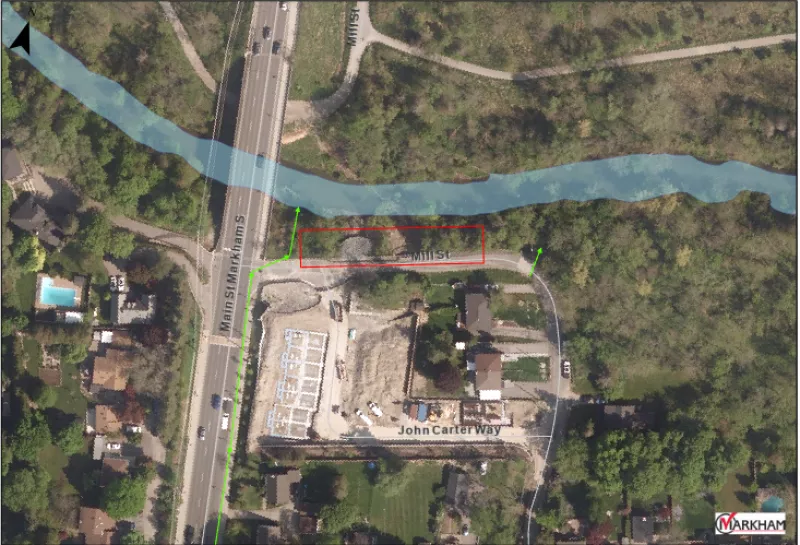
Contact Information:
Timothy Ng, P.Eng.
Project Engineer, Stormwater, Environmental Services Department
Tel: (905) 477-7000 ext. 2374
Email: tng@markham.caErosion Restoration at Spy Court.
Project Description
The City of Markham will be rehabilitating an erosion site southwest of Green Lane and Bronte Road. The stormwater pond berm was breached and poses risk of downstream flooding as the pond cannot control flows to the original design levels.
Project Activities
• Repair of pond berm;
• Grading and top-soil application, installation of erosion control measures;
• Restoration of the project area as per restoration plan and restoration details including Terraseeding and plantings and,
• Clean-up and restoration of the site after completion of the work.Schedule
Construction is scheduled to commence in mid-June 2025.

Contact Information:
Timothy Ng, P.Eng.
Project Engineer, Stormwater, Environmental Services Department
Tel: (905) 477-7000 ext. 2374
Email: tng@markham.caErosion Restoration at German Mills Creek.
Project Description
The City of Markham will be rehabilitating an erosion site just southwest of Green Lane and Bronte Road. The stormwater pond berm was breached and poses risk to downstream flooding as the pond cannot control flows to the original design levels.
Project Activities
• Repair of pond berm;
• Grading and top-soil application, installation of erosion control measures;
• Restoration of the project area as per restoration plan and restoration details including Terraseeding and plantings and,
• Clean-up and restoration of the site after completion of the work.Schedule
Construction is scheduled to commence in mid-June 2025.
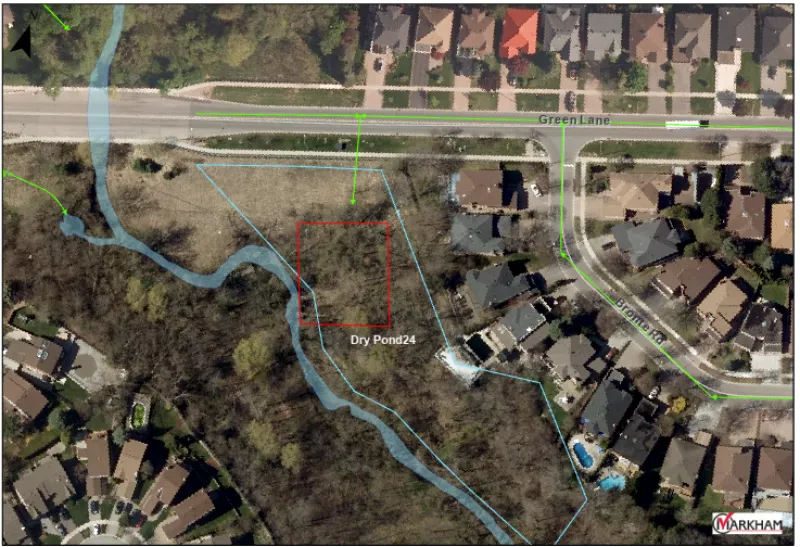
Contact Information:
Timothy Ng, P.Eng.
Project Engineer, Stormwater, Environmental Services Department
Tel: (905) 477-7000 ext. 2374
Email: tng@markham.caErosion Restoration at McCowan Rd.
Project Description
The City of Markham will be rehabilitating an erosion site west of McCowan Road, where the bank of Rouge River experienced a slope failure in 2024 exacerbated by falling trees. The failure then progressed along the rear side of a residential property and an adjacent City park.
Project Activities
• Installation of armourstone retaining wall, rip rap and vegetated buttress;
• Grading and top-soil application, installation of erosion control measures;
• Restoration of the project area as per restoration plan and restoration details;
• Clean-up and restoration of the site after completion of the work.Schedule
Construction is scheduled to commence in May of 2025.
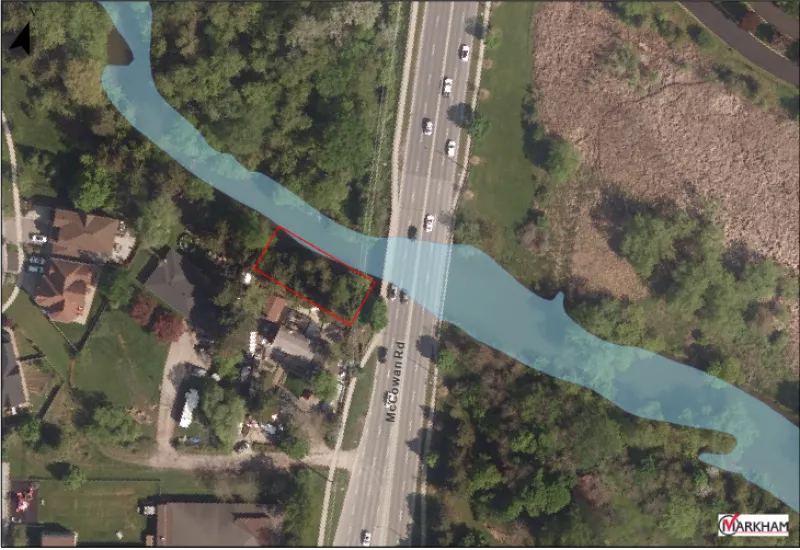
Contact Information:
Vithusan Jeyakanth, P.Eng.
Environmental Engineer, Stormwater, Environmental Services Department
Tel: (905) 477-7000 ext. 2139
Email: vjeyakanth@markham.ca
Erosion Restoration at John St. at German Mills Settlers Park
Project DescriptionThe City of Markham carried out permanent slope restoration work in German Mills Settlers Park, near John Street. This work was required to stabilize the slope that was washed out recently, protect the existing gas main, replace the existing storm sewer on the slope and to restore the functionality to the existing sidewalk and trail.
Project Activities
• Earth excavation, creek channel restoration and bank features;
• Slope surface treatment and restoration;
• New storm sewer pipes, storm manhole, and headwall structures;
• Clean-up and restoration of the site after completion of the workSchedule
• Start Date: mid November 2024
• Substantial Completion: December 2024
• Final Landscaping: Spring 2025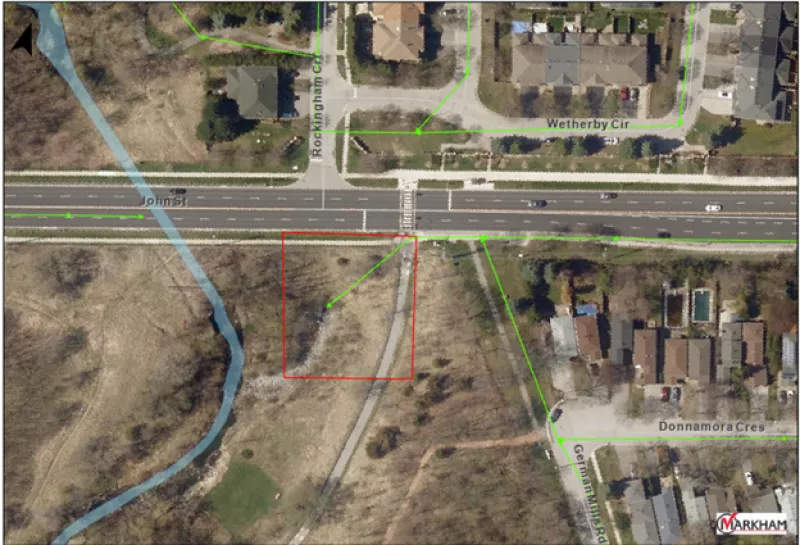
Contact Information:
Zahra Parhizgari, M.Sc. P.Eng. PMP
Environmental Engineer, Stormwater, Environmental Services Department
905.477.7000, Extension 2867
zparhizgari@markham.ca
- Pilot Project for Algae Control (Pond ID #91)
Pilot Project for Algae Control (Pond ID #91)
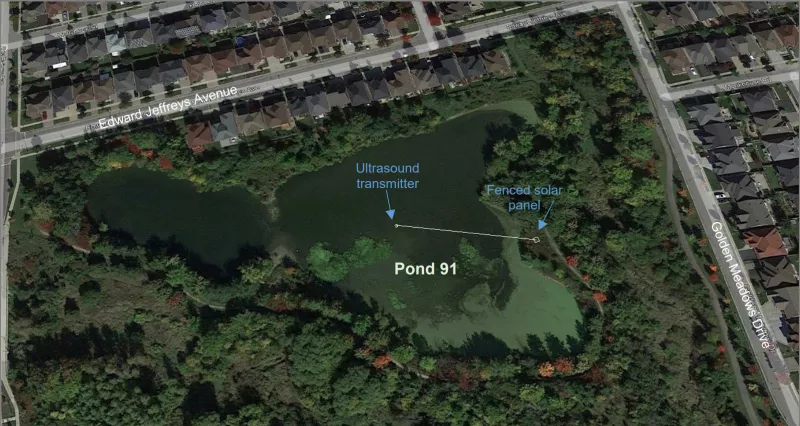
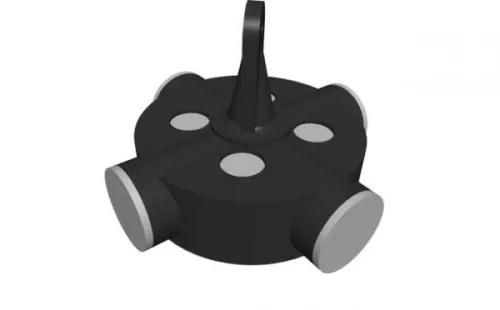
The City of Markham initiated a pilot project in 2023 to control the growth of algae in stormwater pond #91. This pond is located at the southwest corner of Edward Jeffreys Avenue and Golden Meadows Drive.
Some residents of Markham who live near these ponds sometimes worry about the presence of algae in the water. They do not like how it looks and are sometimes concerned that it might harm their health. Algae growth is common in ponds, especially during hot and dry summers. This happens because the water in the ponds contains nutrients that help the algae to grow.
To ensure that ponds are working properly, Markham carries out an annual inspection and maintenance program. Minor issues are resolved each year, while major problems that could affect the pond's performance may require cleaning and improvement.
Since there have been regular complaints about algae levels in some of Markham ponds, the City is testing out projects such as this one for its ‘toolbox’ of management approaches. This pilot project involves using an ultrasonic device, which uses sound waves to control the growth of algae. This is a relatively low-cost and long-lasting technology, and is often used for drinking water reservoirs. The device makes it difficult for algae to float, causing it to sink to the bottom of the pond. In lower light levels, the algae become deactivated. The ultrasound waves are low-powered and do not affect aquatic animals, birds, or humans.
The ultrasound device is powered by a solar panel, which is installed on land, and is fenced off for safety and protection.
Preliminary results in 2023 and 2024 indicated that the treatment was successful in reducing the extent of algae growth on the pond surface considerable. This pilot project will continue in 2025 for further testing and verification.
More information about stormwater ponds management in Markham can be found at Stormwater Management Facilities Maintenance.
If you have any questions or observations during the operation of the device (throughout the summer and fall), please contact the following:
Zahra Parhizgari,
Senior Environmental Engineer
905.477.7000, Extension 2867
zparhizgari@markham.caShould a problem arise after regular working hours or on the weekend, please call the City’s after-hour service at 905.477.7000.
- Markham Village Watermain Upgrades
Markham Village Phase 1A – Watermain Upgrades
- Watermain looping to be done
- Jack Crt
- Jill Crt
- Judy Crt
- Restoration works on above streets occurring May to October 2025
- Construction is ongoing with anticipated completion in Fall 2025
Markham Village Phase 1B – Watermain Upgrades
- Watermain replacement to be done
- Wootten Way N (Church St to Ramona Blvd)
- Sir Tristram Pl
- Sir Gareth Crt (Watermain Looping at end of Court)
- Construction is scheduled to start Spring 2025 with anticipated completion in Fall 2026
- Watermain looping to be done
- Watermain Lining and Replacement
CIPP Watermain Lining Rehabilitation
Construction to commence in April 2025, completion scheduled to be by November 2025 on the following streets:
- Highway 7 (Cosburn Rd to Wootten Way)
- Princess St (Rouge River crossing)
- Tuclor Lane
- Christman Crt
- Green Lane (Guardsman Rd to Hunting Park Dr)
- Guardsman Rd
- Aileen Rd
- Harlech Crt
- Sprucewood Drive (Watermain looping at end of Court, North of Clark Ave)
Cast Iron Watermain Replacement Design
2025 Design and 2026 Construction of the following full or partial streets:
- Proctor Ave
- Steele Valley Rd
- Sprucewood Dr (Steele Valley to CN Corridor)
- Elm Ridge Acres Rd
- Thornlea Rd
- Thornlea Crt
- Albion Close
- Sumner Lane
- Leahill Dr
- Marie Crt
- Paul St
- Orsi Crt
- Thornheights Rd
- Kirk Dr (Yonge St to Shieldmark Cres)
Cast Iron Watermain Replacement – Drakefield Area
- Watermain, services and restoration completed Fall 2023
- Storm Culverts
Storm Culverts (SC04 & SC05 – Henderson Ave to Clark Ave (through Easement)
- Initial pit completed off of Henderson Ave in Fall 2023
- Relining of culvert occurring from June to Sept 2024
- Excavation on Clark Ave has been avoided with changes to construction methodology
Contact
8100 Warden Avenue
Markham, ON, L6G 1B4
Hours
8 AM to 5 PM
